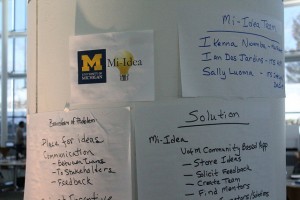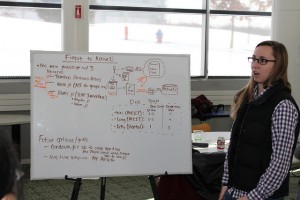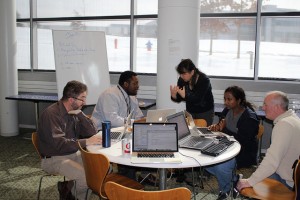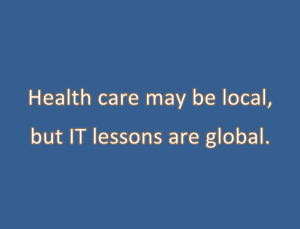According to Wikipedia, “a hackathon (also known as a hack day, hackfest or codefest) is an event in which computer programmers and others involved in software development, including graphic designers, interface designers and project managers, collaborate intensively on software projects”.  Hackathons are a great way to surface problems and prototype solutions in a short time period. I just participated in my first hackathon and what an eye-opener it was.
Hackathons are a great way to surface problems and prototype solutions in a short time period. I just participated in my first hackathon and what an eye-opener it was.
Last week, four different IT groups participated in “Hacks with Friends”: central campus, school of medicine, school of dentistry, and the hospitals and health centers. It was a grassroots event organized by staff. It was great to see such talent and creative energy in one room.

Every available surface was used to brainstorm and organize ideas.
For two days, over 100 participants in 20 teams worked to develop projects in 3 categories – gamification, collaboration, and play (which turned out to be the catch-all category for a problem you wanted to explore or experiment with). Projects could be either externally focused on our customers or internally focused on improving processes for technical staff. Many teams included members from the multiple IT groups solving common problems.
Each team was to develop a minimally viable product (MVP). An MVP is a simple way to address a problem that adds value, is demonstrable. An MVP can be an improved process, a new way of doing things, or an old tool applied in a new way.

Poster presentation proposing FitBit integration with UM’s wellness app.
Each team had to create a winning presentation in three stages. First they needed to create an elevator description of the project, including problem statement, solution and differentiators. Then, they needed a five minute poster presentation. If chosen as a finalist, the team needed to prepare a seven minute demonstration of their product.
To succeed, the team needed to understand the strengths of their team members and welcome a broad range of experiences into the team. Best ideas come from co-design. A great reminder that hackathons are not just for people who can code!
Laura Patterson, the UM CIO, Ted Hanss, the Medical School CIO, and I were the judges. We applied these criteria:
- Fit to category – how well does the project fit the selected category?
- Feasibility – would this work in the real world?
- Completeness – how far did the team get in the allotted time?
- Documentation – did the team document what they learned?

The winning team, “Magic Mirror,” hard at work.
The products proposed were creative and exciting. Some examples:
World of Workcraft – a game to track what we are learning everyday – books, articles, courses, conferences.
Active You – integrating FitBit with the ActiveU mobile app. I think a high percentage of the 11,870 participants in this UM employee wellness program would love this!
Rundeck – a way to automate system administrator tasks using the Rundeck tool.
The winner of the Hacks with Friends event was Magic Mirror – putting student photos in their profiles in the new learning system to help faculty get to know students and students get to know one another. The runner-up was Go Phish – an interactive training tool to help people recognize phishing email leveraging gaming technology.

The coveted “golden hard drive” trophy.
But from another perspective, Activity in Motion (AIM) was the winner for me. This was a team led by Sally Pollock, Manager of IT Service Management from my IT department, that developed a multi-platform application to capture and centralize major incident activity real-time. Benefits include: providing real-time information, minimizing distractions during the major incident call, minimizing the duration of the major incident, capturing a list of participants, making activity highly visible and storing it in a database, where it can be used for reporting and the post incident review process.
The team’s presentation helped me realize the current state of managing major incidents and how a simple app like this could improve the process. I jumped on it. I asked the team to present to my leadership group meeting on Wednesday and we gave directional support for this solution. They will come back in a month with recommendations on how to fit this solution into our current major incident process.
A great example of how a hackathon opened one leader’s eyes to a problem that needed to be solved.
![]() I’ve attended HIMSS many times and have learned how to make the most of my time there. So, whether it’s your first HIMSS or you are a veteran, here are some useful tips:
I’ve attended HIMSS many times and have learned how to make the most of my time there. So, whether it’s your first HIMSS or you are a veteran, here are some useful tips:
 The event was part of their women in non-traditional careers series. It was fun to do – having a chance to encourage and inspire the next generation of information technology professionals. And it was great to see some familiar faces in the audience – a number of women from our IT team decided to attend as well.
The event was part of their women in non-traditional careers series. It was fun to do – having a chance to encourage and inspire the next generation of information technology professionals. And it was great to see some familiar faces in the audience – a number of women from our IT team decided to attend as well.
 You only have to read the news any given week to see the rising number of breaches within health care – the recent Anthem breach being the biggest to date with over 80 million records involved. And there is a new breach we are all hearing about as of this week – Premera Blue Cross potentially involving financial and medical records of up to 11 million customers.
You only have to read the news any given week to see the rising number of breaches within health care – the recent Anthem breach being the biggest to date with over 80 million records involved. And there is a new breach we are all hearing about as of this week – Premera Blue Cross potentially involving financial and medical records of up to 11 million customers. Hackathons are a great way to surface problems and prototype solutions in a short time period. I just participated in my first hackathon and what an eye-opener it was.
Hackathons are a great way to surface problems and prototype solutions in a short time period. I just participated in my first hackathon and what an eye-opener it was.



 This is part of Lean in Daily Work which also includes key visual metrics, visual boards, Everyday Lean Ideas (ELI), and leadership walks.
This is part of Lean in Daily Work which also includes key visual metrics, visual boards, Everyday Lean Ideas (ELI), and leadership walks. You think you’ve nailed the interview. You’ve met with lots of people. You like them and your potential new boss. You think it’s a great opportunity and you are excited about the prospects. You anxiously wait for “the call”. And then it comes. The hiring manager, HR person, or recruiter says “we’re going in another direction” – that common euphemism to say that someone else is getting the job. They go on to say some nice things about you and that you interviewed well but all you hear is that you didn’t get the job.
You think you’ve nailed the interview. You’ve met with lots of people. You like them and your potential new boss. You think it’s a great opportunity and you are excited about the prospects. You anxiously wait for “the call”. And then it comes. The hiring manager, HR person, or recruiter says “we’re going in another direction” – that common euphemism to say that someone else is getting the job. They go on to say some nice things about you and that you interviewed well but all you hear is that you didn’t get the job. Interviewing for a new job? Remember when you interviewed for your current position? Any way you slice it, job interviews will cause stress but they can also be a growth opportunity.
Interviewing for a new job? Remember when you interviewed for your current position? Any way you slice it, job interviews will cause stress but they can also be a growth opportunity.
 You’re just glad that you don’t have to get up at the crack of dawn to shovel out your driveway and try to get down your unplowed street.
You’re just glad that you don’t have to get up at the crack of dawn to shovel out your driveway and try to get down your unplowed street.